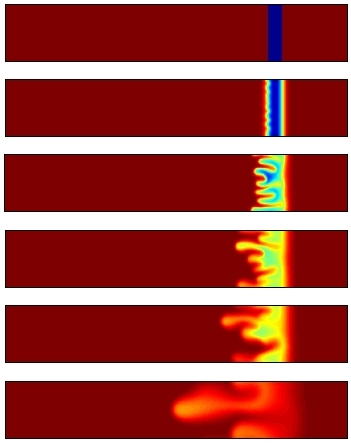Viscous fingering of miscible fluids
|

|
When a fluid displaces a more viscous one, the interface between the two fluids does not remain flat and perpendicular to the flow axis. Instead, since, for a given pressure gradient, the less viscous fluid moves faster than the more viscous one, it deforms the interface into fingers growing in time. Such a fingering instability occurs typically when less viscous water displaces more viscous oil in underground reservoirs leading to viscous fingering which produces flow nonuniformity and reduces oil recovery. Fingering poses also problems in contaminant transport in aquifers, in packed bed reactors, and is particularly detrimental to chromatographic separation techniques. Indeed, since samples injected in chromatographic columns or pollution zones have generally a viscosity different from that of the carrier fluid, fingering occurs at the front or tail of the sample zone when the sample viscosity is, respectively smaller or larger than that of the invading fluid. In any case, this instability leads to distortion and broadening of the samples. The resulting deterioration of the separation can be serious, especially for highly concentrated samples in preparative or size-exclusion chromatography and for highly viscous aquifer contaminants. In this context, it is our goal to investigate both experimentally and theoretically the influence of viscous fingering on the spreading of viscous samples.

Publications
|
Viscous fingering of miscible slices |
[  | |  ] ] |
| A. De Wit, Y. Bertho and M. Martin, Phys. Fluids 17, 054114 (2005) |
|






